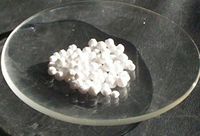Difference between revisions of "Potassium bromide"
(→Chemical) |
|||
| Line 115: | Line 115: | ||
However, bromine is not as strong an oxidiser as [[chlorine]], so chlorine will form bromine if reacted with a solution of bromide. | However, bromine is not as strong an oxidiser as [[chlorine]], so chlorine will form bromine if reacted with a solution of bromide. | ||
| − | :2 | + | :2 KBr + Cl<sub>2</sub> → 2 KCl + Br<sub>2</sub> |
Bromide ions can be oxidised to [[Potassium bromate|bromate]], which is a powerful oxidiser. | Bromide ions can be oxidised to [[Potassium bromate|bromate]], which is a powerful oxidiser. | ||
Revision as of 21:08, 14 November 2016

| |
| Names | |
|---|---|
| IUPAC name
Potassium bromide
| |
| Properties | |
| KBr | |
| Related compounds | |
| Related compounds
|
Potassium chloride Potassium iodide |
| Except where otherwise noted, data are given for materials in their standard state (at 25 °C [77 °F], 100 kPa). | |
| Infobox references | |
Potassium bromide (KBr) is a very stable and common bromide salt. It is commonly used to produce elemental bromine.
Contents
Properties
Chemical
Potassium bromide's properties are very similar to potassium chloride. The reaction with sulfuric acid produces hydrobromic acid, in the same way the chloride analogue produces hydrochloric acid.
However, bromine is not as strong an oxidiser as chlorine, so chlorine will form bromine if reacted with a solution of bromide.
- 2 KBr + Cl2 → 2 KCl + Br2
Bromide ions can be oxidised to bromate, which is a powerful oxidiser.
Physical
A white, nondescript solid, its density is high, and often samples are much heavier than what one subconsciously expects the crystalline white powder to weigh.
It dissolves quite easily to form a clear solution. If even small amounts of bromine is made in a reaction, the colour of the solution shifts to a vivid orange as some bromine is somewhat soluble in a solution of bromide ions, forming the tribromide ion.
Potassium bromide, unusually, has covalent properties in the gas phase. It does, however, have one of the highest known dipole moments.
Availability
Potassium bromide is sometimes found as brominating tablets at pool stores as an alternative to chlorine. Other than this it is rarely found in consumer outlets but can be found easily and cheaply online or at any chemical supply store.
Preparation
Reacting elemental bromine with potassium hydroxide or potassium iodide will produce the potassium bromide salt:
- KOH + Br2 → KBr + HOBr
- KI + Br2 → KBr + I2
Hydrobromic acid can also be used instead of elemental bromine for the first reaction:
- KOH + HBr → KBr + H2O
Projects
- Producing elemental bromine
- Potassium bromate
- Make hydrobromic acid
Handling
Safety
Bromide ions are a cumulative poison, staying in the blood for over a week. The only feasible routes of exposure are through purposefully consuming the solid or drinking solutions, neither of which is likely to occur, so it can be regarded as safe, provided high direct exposures to the body are limited.
Storage
Potassium bromide should be stored in closed containers.
Disposal
Can be safely poured down the drain.
References
http://en.m.wikipedia.org/wiki/Potassium_bromide (for toxicity data. Contains much more information about how your body deals with bromide ions)